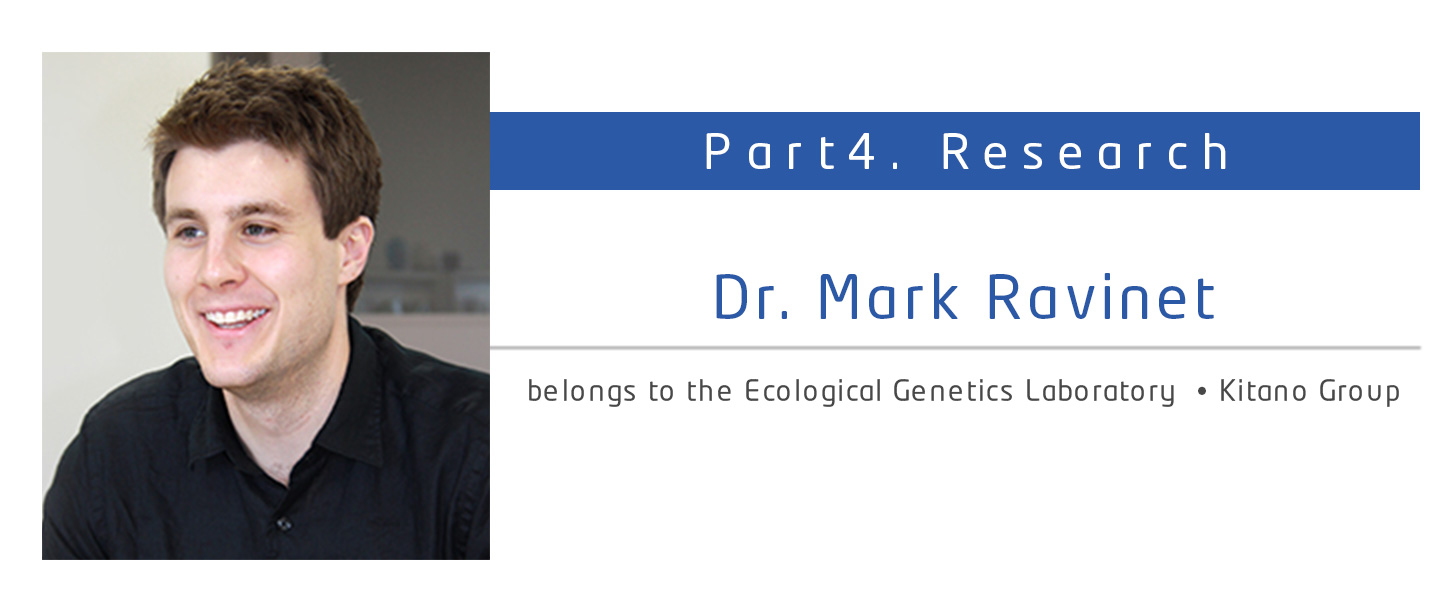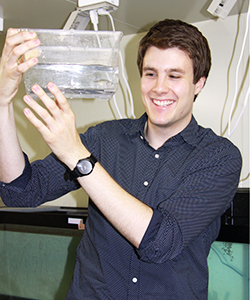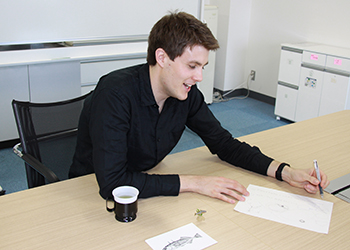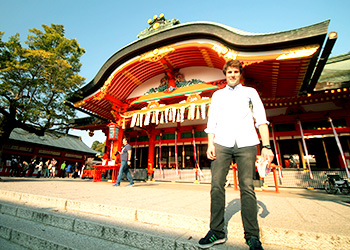Dr. Mark Ravinet

Question 1 Would you mind to explain us your research ?
As an evolutionary biologist my work focuses on speciation and adaptation and in particular how natural selection contributes to these two processes. When most people think of evolution, they think of natural selection. While selection clearly drives adaptation, it is quite recent that we really understand how important selection and adaptation are for speciation.
A lack of gene flow is fundamental to species formation; when barriers to gene flow evolve, speciation occurrs. Strong divergent selection between populations in different ecosystems can cause ecological speciation to occur very rapidly and is known as ecological speciation. While ecological speciation does reduce gene flow, there are still many things we don’t understand about it. How does divergent selection affect the genome? Is ecologically mediated selection alone enough to cause irreversible speciation?
Right now is an excellent time to be a young researcher in this field because we can now actually answer some of these questions. Decreasing costs of high-throughput sequencing technologies mean it is possible to genotype large numbers of individuals at thousands of genetic markers or even re-sequence entire genomes. With this sort of data we can test for divergent selection, identify potential candidate genes, quantify gene flow, estimate population history and much more.
In the Ecological Genetics Laboratory we work on the three-spined stickleback (Gasterosteus aculeatus), a major study organism for speciation and adaptation. Sticklebacks are ancestrally marine but they have repeatedly and independently colonised freshwater environments across the northern hemisphere during the last 20 000 years. This means adaptation to freshwater has occurred in parallel in many different populations. Sticklebacks have also evolved a remarkable number of species pairs in different ecosystems due to ecological speciation.
In Japan however there is a unique marine species pair made up of two highly divergent lineages. Pacific Ocean and Japan Sea sticklebacks probably first diverged during the isolation of the Sea of Japan around 1.5 million years ago, although this hypothesis has not been formally tested.
I am currently using whole genome sequence and population genomics data to reconstruct the evolutionary history of these two lineages. I want to know whether divergence times across the genome are consistent with the hypothesis of isolation 1.5 million years ago. Since the lab is focusing on many different aspects of speciation in this system such as the evolution of divergent sex chromosomes and the genetic architecture underlying divergent traits, having a better understanding of the speciation context and ancestral population demography is very important.

I am also working on the population genomics of speciation in this system. It seems quite clear that gene flow has occurred between these lineages, even though they are very divergent. Using population genomic data, I am comparing the extent of gene flow and selection across the distribution of these two lineages. Has gene flow been more recent, between co-occurring populations? Or is it more ancient, having occurred during the divergence process?
It’s important to note that the application of population genomics data to these sorts of questions is still relatively in its infancy. There are still a lot of assumptions made about population genomic markers for example. Since finishing my PhD in 2012, I have been specialising in population genomic data analysis. In addition to my work on the stickleback system, I have been using high-throughput sequence data to understand parallel adaptation in Swedish populations of the rough periwinkle (Littorina saxatilis) a marine snail. I am also interested in testing and understanding these new methods in more detail. My work here and in Sweden has identified several potential issues with these methods. I am now working on using simulation data to get a clearer idea of what is causing these issues and to hopefully develop new methods to overcome them.
Question 2 How did you know NIG?

I first came to NIG in early 2012 as part of the JSPS Short-term Postdoctoral Fellowship for Foreign Researchers Program. By lucky coincidence, I had just read a paper by Professor Kitano on Japanese sticklebacks the day before I saw the grant advert. I wondered if anyone had tested whether ecological divergence had contributed to speciation in his study system. So I wrote to him and it turned out he needed a postdoc to test it.
Although I did have to return to Europe, Professor Kitano and I applied for a long-term JSPS Postdoctoral Fellowship and we were successful. So I was very happy to return to NIG in 2014.
Actually I was indirectly aware of NIG. I studied Population Genetics during my PhD and so obviously I was familiar with the work of Motoo Kimura and Tomoko Ohta, but it wasn’t until I first wrote to Professor Kitano that I realised he was based at the same institute where the neutral theory of molecular evolution was established!
Question 3 What is the merit of working/ studying at NIG?
I find NIG and the lab a free environment to pursue research. Our lab is small but the other members are all very talented researchers who discuss issues and research questions constantly. It’s a very intellectually stimulating environment to work in.
In NIG, there are many researchers here specialising in all sorts of aspects of genetic research and it’s really helpful to be able to discuss my work with them, too. A different perspective can often lead to a whole new avenue of research. Since my background was originally ecology and evolution, I enjoy going to the seminars and journal clubs so I can learn more about molecular genetics.
Question 4 What’s your impression of Mishima-City?
I honestly love Mishima! A lot of people inside and outside NIG think it’s too quiet. Well it is quite a small town but since I used to live on a remote island in Sweden, I find it hard to agree there is nothing happening here! There are some excellent restaurants, bars and cafes here, too. I live in the heart of the downtown area and it just feels vibrant. I guess many local residents are living from generation to generation. They are really surprised every time someone sees me.
Of course for me, Japan is completely different to where I grew up; so almost every day I discover something new about the country. Living in Mishima can be a bit challenging if you don’t speak much Japanese but I enjoy that aspect of it too because it means I am always learning.
Besides, an elderly couple barber giving me a gift whenever I go there for my hair cut, somebody always trying to show me the way when I am reading a map on the street…I have enough funny stories of encounters with locals to last me a lifetime!
Question 5 How do you spend your day off/ holiday?

I’m pretty active so I do a lot of running, swimming and cycling. I don’t want to spend all this time in Japan and only ever see the lab! It’s a good way to relax after work and it’s also a good time to think about research too.
I’ve got a nice group of friends outside of NIG I meet up with pretty regularly for drinks and food at a very nice Irish pub in Mishima.
I also enjoy exploring Japan. As my Japanese is getting better, I’m finding the confidence to try “off the rails” that most western tourists don’t go to.
However I have an ulterior motive when I go travelling. It’s no secret that I have become a huge fan of ramen while living in Japan. I have been known to travel by train for a couple of hours to reach a famous shop or two.
Question 6 What would you like to achieve in the future?
It is a very difficult question! I can’t imagine myself doing something else because it gives me too much satisfaction, so I know that I want to continue my research career to the highest levels, long into the future.
Ultimately though, I’d like to really focus on a main research topic and build up my own laboratory with an aim to investigate it thoroughly. I think Professor Kitano is a good model for that sort of career.
Alongside a fulfilling career, I would also like to live a fulfilling life. I don’t want to be like scientists who have achieved a lot but have nothing outside of work. One of my personal heroes is Charles Darwin and he changed the way we look at the world, never stopped learning or thinking and had a very happy family life. I doubt I’ll manage the first one, but perhaps I can achieve the other two.
transcription & translation : Chikako Miura (General Affairs/Education Team)
Back














